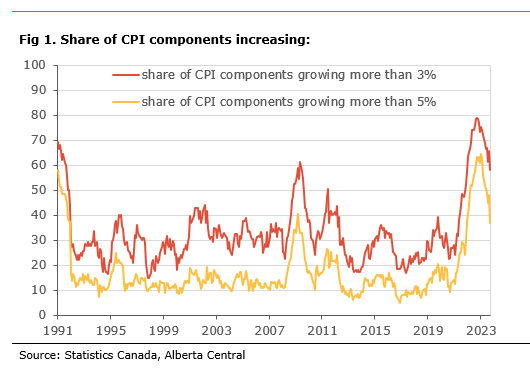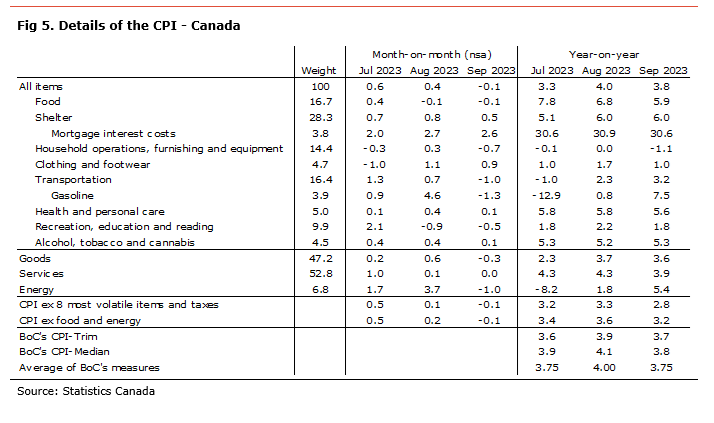Economic commentary provided by Alberta Central Chief Economist Charles St-Arnaud.
Bottom line
Inflation decelerated to 3.8% in August, more than expected. The lower inflation rate is mainly the result of slower price increases for food, durable goods and travel services. However, higher gasoline prices offset part of this deceleration. More importantly, all measures of underlying inflationary pressures decelerated in September, suggesting that the surprise increase seen in August was likely temporary.
Inflationary pressures also narrowed significantly, with 37% of the components of CPI rising at more than 5%, compared to 48% in July. Similarly, the share of components increasing by more than 3% dropped to 58% (see Fig 1.). This more than erased the increase in these metrics seen in August, a development that the Bank of Canada will welcome.
The recent trend in CPI’s monthly changes suggests that the momentum in inflationary pressures eased in September, but remains elevated. As such, we observe that many of the 3-month annualized changes in some key CPI components (shelter and transportation) are still higher than the year-on-year changes, suggesting further possible acceleration in those components. On the flip side, it is below for food prices. (see Fig. 2) The 3-month annualized changes in headline CPI is now at 5.7%, after 6.0% in August. Similarly, the same measure for the BoC’s core measures increased by 3.7% on average, suggesting continued strong price pressures. CPI excluding food and energy is at 3.3%, also above the BoC’s target range, while it is 2.4% for the BoC’s old measure of core (CPI ex the 8 most volatile components and indirect taxes).
The broad deceleration in most measures of core inflation will ease some of the BoC worries. More particularly, the fact that inflation momentum, as measured by the 3-month annualized changes, in most core measures has decelerated suggests that inflation is no longer accelerating. However, their levels continue to point to stickiness above 3%.
With oil prices and gasoline prices having eased in recent weeks, headline inflation is expected to moderate further in the coming months and average about 3.3% for the rest of the year. Similarly, measures of core inflation are expected to continue to moderate slightly.
The reversal of some of the upside surprises in inflation seen in August lowers the probability that the BoC may increase its policy rate before the end of the year. The decision continues to hinge on whether the domestic economy slows, reducing excess demand and wage growth, and whether we continue to see some moderation in inflationary pressures.
In Alberta, inflation eased to 3.7%. The deceleration was mainly due to a moderation in shelter costs, contributing 2.5pp percentage points to inflation. Food prices also decelerated and remained one of the main sources of inflation. Inflation excluding food and energy (a measure of core inflation) declined to 2.5% and remained below the national measure.
The Consumer Price Index (CPI) decreased by 0.1% m-o-m non-seasonally-adjusted in September and the inflation rate decelerated to 3.8%. This was weaker than expected. Prices declined on the month in five of the eight major CPI components, led by transportation costs (-1.0% m-o-m) due to a 1.3% m-o-m drop in gasoline prices. Household operations, furnishing and equipment costs declined 0.7% m-o-m, trhanks to lower furniture prices and communication costs, while recreation, education and reading declined (-0.6% m-o-m), due to lower travel service costs (-2.6% m-o-m). Food prices eased for a second consecutive months (-0.1% m-o-m).
Six of the eight major CPI components decelerated in decelerated on a year-on-year basis. Food price inflation declined to 5.9%, its lowest since January 2022, but remains one of the main source of inflation, contributing 1.0 percentage points (pp). Household operations, furnishing and equipment costs were lower than last year (-1.1% y-o-y), thanks to lower mobile services prices, and reducing inflation by 0.2pp.
Shelter costs inflation remained unchanged at 6.0% y-o-y and is the main source of inflation, contributing 1.7 percentage points (pp), with about 1.16pp attributable to higher mortgage interest costs and 0.5pp due to higher rent. Transportation costs increased 3.2% y-o-y, adding 0.5pp to inflation, with gasoline prices rising 7.5% y-o-y.
In August, goods prices inflation eased to 3.6% from 3.7%, while services inflation decelerarted to 3.9% from 4.3%. Energy prices rose 5.4% y-o-y compared to the same month last year. Excluding food and energy, prices declines 0.1% on the month and increased by 3.2% compared to the same month last year, its lowest since November 2021. The Bank of Canada’s old measure of core inflation, CPI excluding the 8 most volatile components and indirect taxes, was edged lower to 2.8%, below the upper band of the Bank of Canada’s operational target and its lowest since June 2021.
Looking at the BoC’s core measures of inflation, all indicators decelerated in September. CPI-Trim eased to 3.7% from 3.9% and CPI-Median to 3.8% from 4.1%. As a result, the average of the two measures increased to 4.00% from 3.75%.
In Alberta, inflation dropped to 3.9% in September from 4.3%. The main source of inflation deceleration was shelter costs rose 9.7% y-o-y and remained the main source of inflation, contributing 2.5pp to inflation. higher electricity prices, owned accommodation costs and rent compared to last year are the main source of inflation in this category. Food prices decelerated to 5.5% y-o-y and remained an important source of inflation in the province, contributing 0.9pp to inflation. Transportation costs rose 1.6% y-o-y due to higher gasoline prices. A decline in household operations, furnishing and equipment (-2.8% y-o-y), resulting from lower communication costs, reduced inflation by 0.4pp.
Goods prices inflation dropped to 4.1% from 5.0%, while services prices eased to 3.2% from 3.5%. Inflation excluding food and energy edged lower to 2.5%, its lowest since January 2022, while energy costs rose 12.6% y-o-y.





Independent Opinion
The views and opinions expressed in this publication are solely and independently those of the author and do not necessarily reflect the views and opinions of any organization or person in any way affiliated with the author including, without limitation, any current or past employers of the author. While reasonable effort was taken to ensure the information and analysis in this publication is accurate, it has been prepared solely for general informational purposes. There are no warranties or representations being provided with respect to the accuracy and completeness of the content in this publication. Nothing in this publication should be construed as providing professional advice on the matters discussed. The author does not assume any liability arising from any form of reliance on this publication.